Strategy Enterprise & Innovation: Waitrose Competitive Forces Analysis
VerifiedAdded on 2023/06/17
|14
|3687
|182
Report
AI Summary
This report provides a comprehensive analysis of Waitrose, a prominent British supermarket, using various strategic frameworks. It begins by analyzing Waitrose's internal resources and capabilities through a SWOT analysis, identifying strengths such as its own-brand products and partnership with John Lewis, weaknesses like its perception as a retailer for high earners, opportunities for market penetration, and threats from competitors. The VRIO framework assesses the value, rarity, imitability, and organization of Waitrose's resources. Furthermore, the report examines the external environment using PESTLE analysis, considering political, economic, social, technological, legal, and environmental factors impacting Waitrose. Finally, Porter's Five Forces framework is applied to evaluate the competitive forces within the supermarket industry, including the level of competition, threat of substitutions, bargaining power of suppliers and customers, and the threat of new entrants, ultimately providing insights into Waitrose's strategic position and competitive landscape.
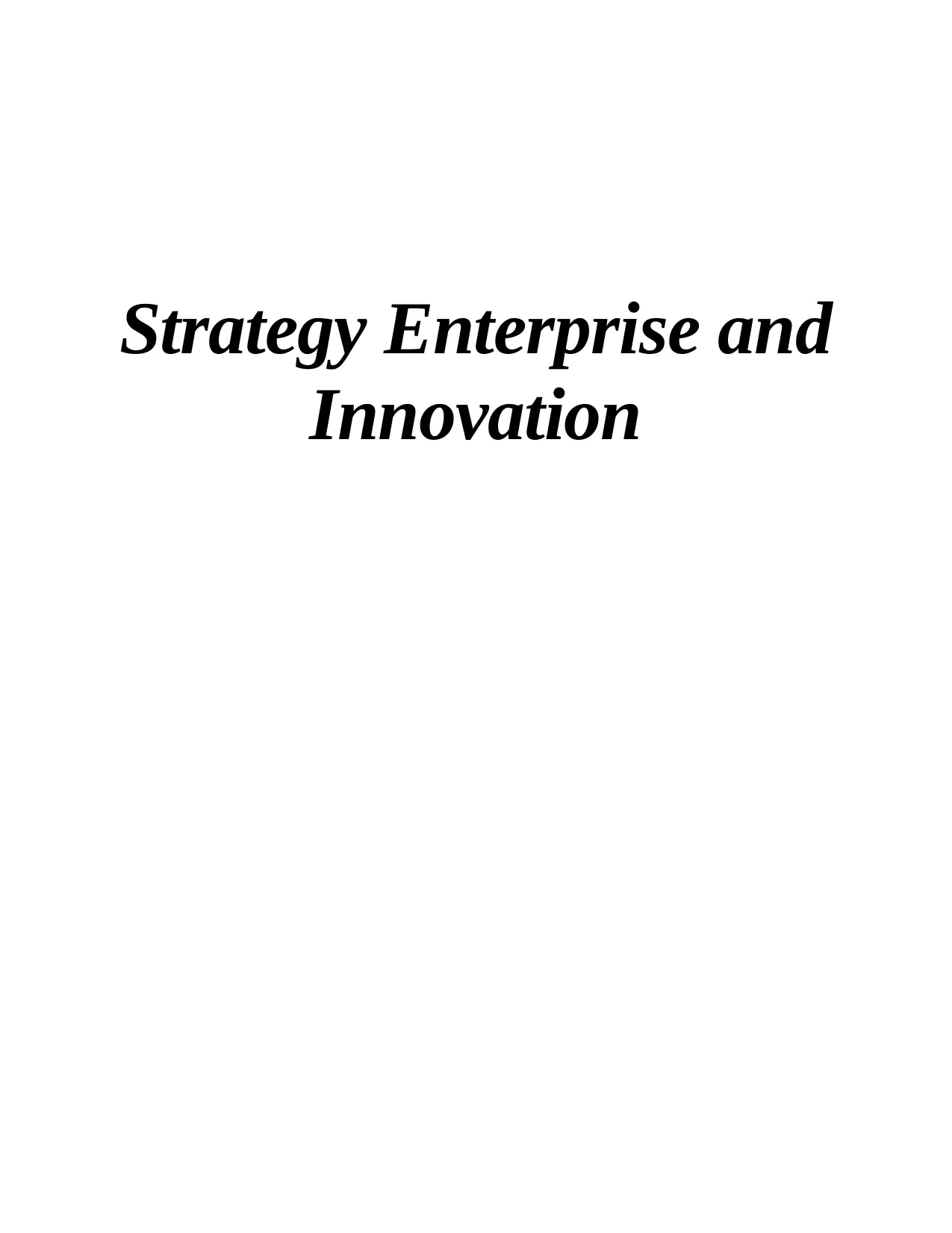
Strategy Enterprise and
Innovation
Innovation
Paraphrase This Document
Need a fresh take? Get an instant paraphrase of this document with our AI Paraphraser
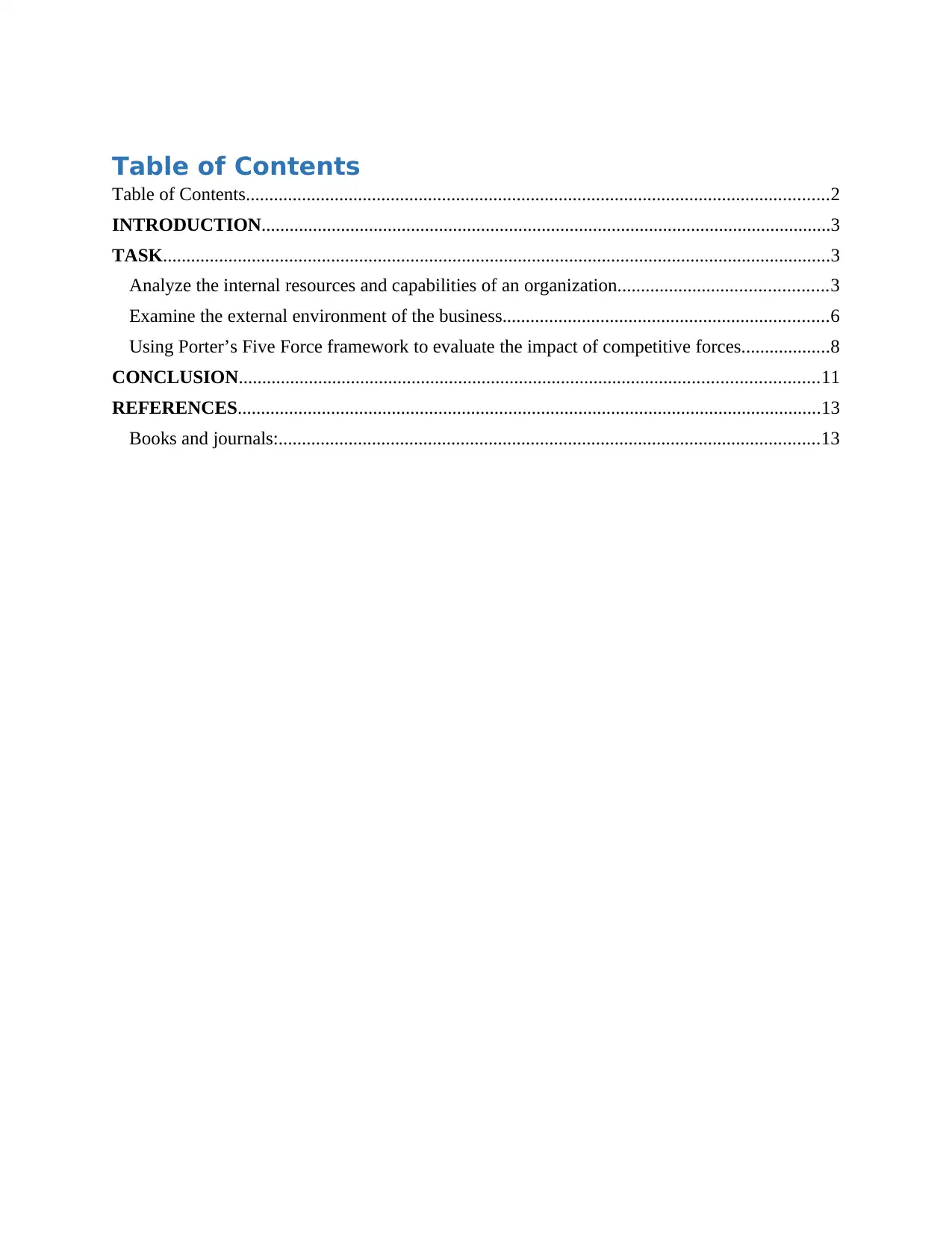
Table of Contents
Table of Contents.............................................................................................................................2
INTRODUCTION..........................................................................................................................3
TASK...............................................................................................................................................3
Analyze the internal resources and capabilities of an organization.............................................3
Examine the external environment of the business......................................................................6
Using Porter’s Five Force framework to evaluate the impact of competitive forces...................8
CONCLUSION............................................................................................................................11
REFERENCES.............................................................................................................................13
Books and journals:....................................................................................................................13
Table of Contents.............................................................................................................................2
INTRODUCTION..........................................................................................................................3
TASK...............................................................................................................................................3
Analyze the internal resources and capabilities of an organization.............................................3
Examine the external environment of the business......................................................................6
Using Porter’s Five Force framework to evaluate the impact of competitive forces...................8
CONCLUSION............................................................................................................................11
REFERENCES.............................................................................................................................13
Books and journals:....................................................................................................................13

INTRODUCTION
Waitrose is one of the famous supermarket in British administration. In 1904, it was founded as
Waite, Rose and Taylor, later it shortened to Waitrose. In 1937, the company was acquired by
John Lewis Partnership that is an employee owned retailer, which sells merchandise under the
name of this company. It was headquartered in Bracknell, Berkshire and Victoria, London, UK.
It is recognized as the eighth largest groceries retailer in the country. It has 332 shops, involving
65 “little Waitrose” convenience shops across the UK. It has allocated their business in over 52
countries (Alfayad, 2021). It owns royal warrant to supply spirits, wine and groceries to Queen
Elizabeth II. The following report will analyze internal and external business environment as
well as porter's five forces framework will be used in order to identify the impact of competitive
forces.
TASK
Analyze the internal resources and capabilities of an organization.
Business strategies defines a sum of competitive moves or actions that a company uses to
strengthening its performance, attract customers, achieve organizational goals as well as to
complete successfully.
SWOT analysis helps to examine the strengths, weaknesses, threats and opportunities of
business. In context of Waitrose, it is a management tool that enables it to benchmark its
performance and competitive edge in the market. The following is the SWOT analysis to
examine the internal environment of the brand:
Strengths-
One of the biggest strengths of the brand is that it has its own brand in order to sell its product
with private label, which are mostly all of them faitrade or organic, free range, consisting their
own products which encourage their new and healthy lifestyle of their consumers. The chosen
company owns farms working with its farmers, suppliers and growers. It also ensures to maintain
its business standards in safety, quality, animal welfare and environment across its chain of
supply assisted by its own farm insurance schemes and inspections. A healthy bond with their
farmers is also essential as it can guarantee that the goods will be reliable and expected. The
chosen company shares a significant partnership with John Lewis, which advances the brand
Waitrose is one of the famous supermarket in British administration. In 1904, it was founded as
Waite, Rose and Taylor, later it shortened to Waitrose. In 1937, the company was acquired by
John Lewis Partnership that is an employee owned retailer, which sells merchandise under the
name of this company. It was headquartered in Bracknell, Berkshire and Victoria, London, UK.
It is recognized as the eighth largest groceries retailer in the country. It has 332 shops, involving
65 “little Waitrose” convenience shops across the UK. It has allocated their business in over 52
countries (Alfayad, 2021). It owns royal warrant to supply spirits, wine and groceries to Queen
Elizabeth II. The following report will analyze internal and external business environment as
well as porter's five forces framework will be used in order to identify the impact of competitive
forces.
TASK
Analyze the internal resources and capabilities of an organization.
Business strategies defines a sum of competitive moves or actions that a company uses to
strengthening its performance, attract customers, achieve organizational goals as well as to
complete successfully.
SWOT analysis helps to examine the strengths, weaknesses, threats and opportunities of
business. In context of Waitrose, it is a management tool that enables it to benchmark its
performance and competitive edge in the market. The following is the SWOT analysis to
examine the internal environment of the brand:
Strengths-
One of the biggest strengths of the brand is that it has its own brand in order to sell its product
with private label, which are mostly all of them faitrade or organic, free range, consisting their
own products which encourage their new and healthy lifestyle of their consumers. The chosen
company owns farms working with its farmers, suppliers and growers. It also ensures to maintain
its business standards in safety, quality, animal welfare and environment across its chain of
supply assisted by its own farm insurance schemes and inspections. A healthy bond with their
farmers is also essential as it can guarantee that the goods will be reliable and expected. The
chosen company shares a significant partnership with John Lewis, which advances the brand
⊘ This is a preview!⊘
Do you want full access?
Subscribe today to unlock all pages.

Trusted by 1+ million students worldwide
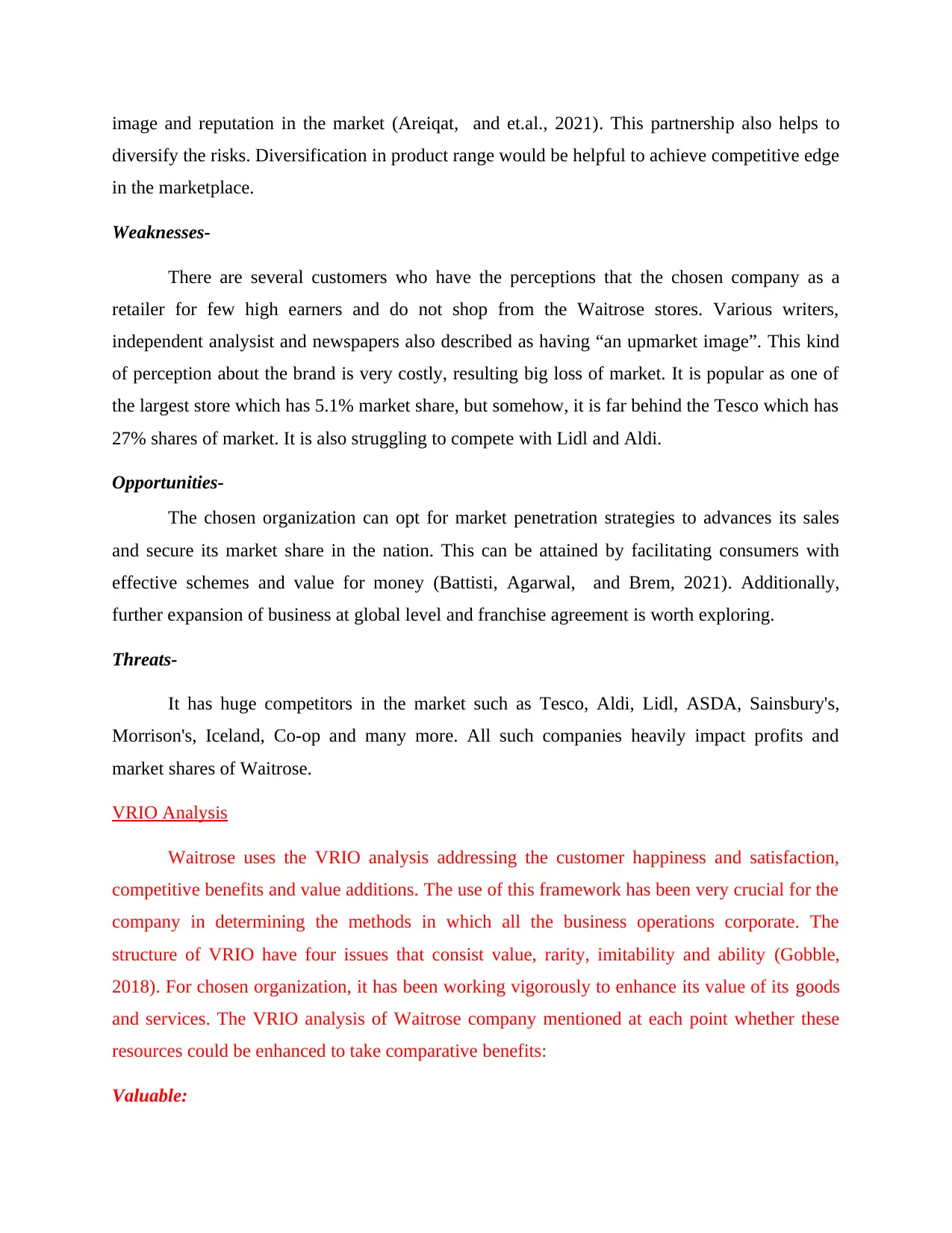
image and reputation in the market (Areiqat, and et.al., 2021). This partnership also helps to
diversify the risks. Diversification in product range would be helpful to achieve competitive edge
in the marketplace.
Weaknesses-
There are several customers who have the perceptions that the chosen company as a
retailer for few high earners and do not shop from the Waitrose stores. Various writers,
independent analysist and newspapers also described as having “an upmarket image”. This kind
of perception about the brand is very costly, resulting big loss of market. It is popular as one of
the largest store which has 5.1% market share, but somehow, it is far behind the Tesco which has
27% shares of market. It is also struggling to compete with Lidl and Aldi.
Opportunities-
The chosen organization can opt for market penetration strategies to advances its sales
and secure its market share in the nation. This can be attained by facilitating consumers with
effective schemes and value for money (Battisti, Agarwal, and Brem, 2021). Additionally,
further expansion of business at global level and franchise agreement is worth exploring.
Threats-
It has huge competitors in the market such as Tesco, Aldi, Lidl, ASDA, Sainsbury's,
Morrison's, Iceland, Co-op and many more. All such companies heavily impact profits and
market shares of Waitrose.
VRIO Analysis
Waitrose uses the VRIO analysis addressing the customer happiness and satisfaction,
competitive benefits and value additions. The use of this framework has been very crucial for the
company in determining the methods in which all the business operations corporate. The
structure of VRIO have four issues that consist value, rarity, imitability and ability (Gobble,
2018). For chosen organization, it has been working vigorously to enhance its value of its goods
and services. The VRIO analysis of Waitrose company mentioned at each point whether these
resources could be enhanced to take comparative benefits:
Valuable:
diversify the risks. Diversification in product range would be helpful to achieve competitive edge
in the marketplace.
Weaknesses-
There are several customers who have the perceptions that the chosen company as a
retailer for few high earners and do not shop from the Waitrose stores. Various writers,
independent analysist and newspapers also described as having “an upmarket image”. This kind
of perception about the brand is very costly, resulting big loss of market. It is popular as one of
the largest store which has 5.1% market share, but somehow, it is far behind the Tesco which has
27% shares of market. It is also struggling to compete with Lidl and Aldi.
Opportunities-
The chosen organization can opt for market penetration strategies to advances its sales
and secure its market share in the nation. This can be attained by facilitating consumers with
effective schemes and value for money (Battisti, Agarwal, and Brem, 2021). Additionally,
further expansion of business at global level and franchise agreement is worth exploring.
Threats-
It has huge competitors in the market such as Tesco, Aldi, Lidl, ASDA, Sainsbury's,
Morrison's, Iceland, Co-op and many more. All such companies heavily impact profits and
market shares of Waitrose.
VRIO Analysis
Waitrose uses the VRIO analysis addressing the customer happiness and satisfaction,
competitive benefits and value additions. The use of this framework has been very crucial for the
company in determining the methods in which all the business operations corporate. The
structure of VRIO have four issues that consist value, rarity, imitability and ability (Gobble,
2018). For chosen organization, it has been working vigorously to enhance its value of its goods
and services. The VRIO analysis of Waitrose company mentioned at each point whether these
resources could be enhanced to take comparative benefits:
Valuable:
Paraphrase This Document
Need a fresh take? Get an instant paraphrase of this document with our AI Paraphraser
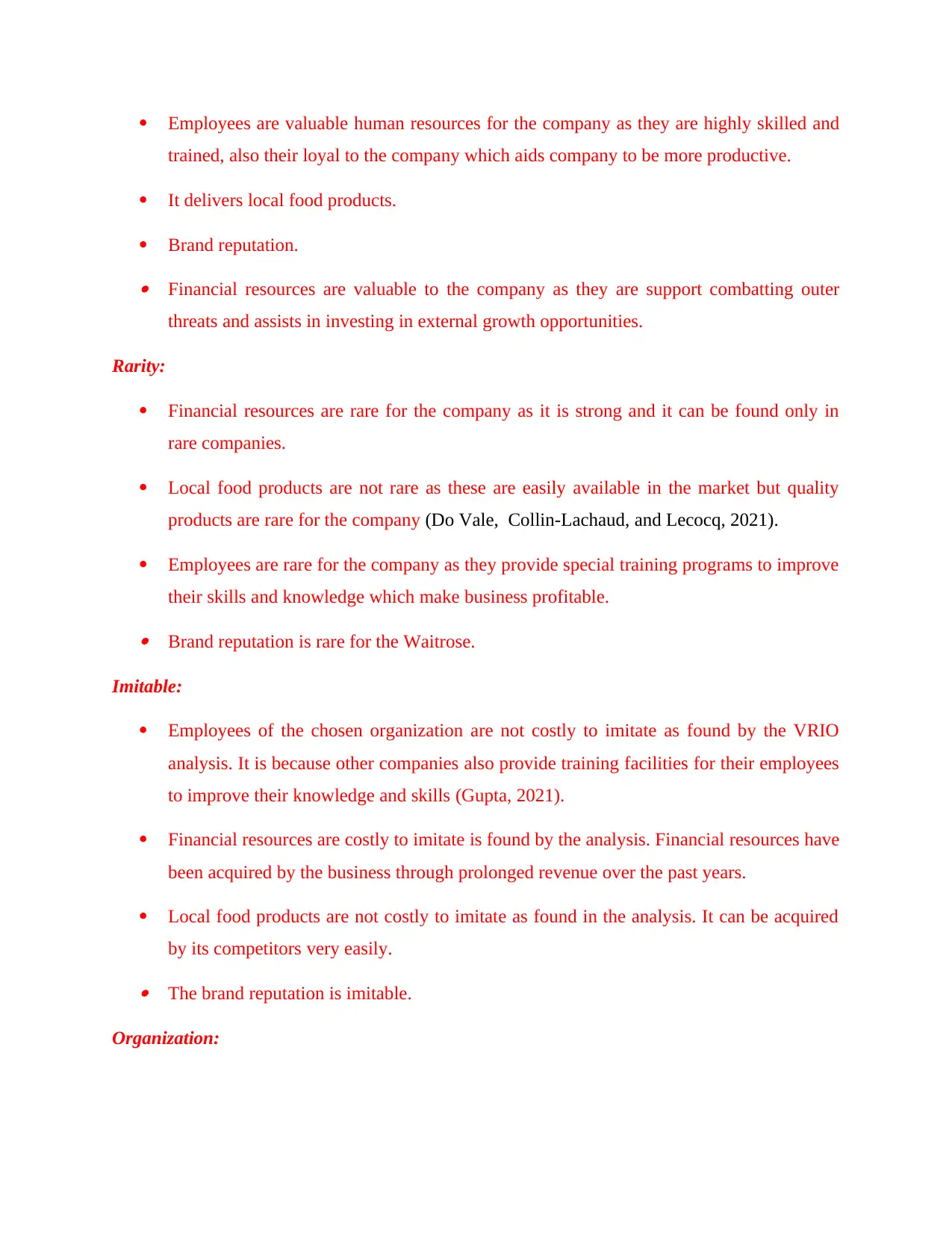
Employees are valuable human resources for the company as they are highly skilled and
trained, also their loyal to the company which aids company to be more productive.
It delivers local food products.
Brand reputation. Financial resources are valuable to the company as they are support combatting outer
threats and assists in investing in external growth opportunities.
Rarity:
Financial resources are rare for the company as it is strong and it can be found only in
rare companies.
Local food products are not rare as these are easily available in the market but quality
products are rare for the company (Do Vale, Collin-Lachaud, and Lecocq, 2021).
Employees are rare for the company as they provide special training programs to improve
their skills and knowledge which make business profitable. Brand reputation is rare for the Waitrose.
Imitable:
Employees of the chosen organization are not costly to imitate as found by the VRIO
analysis. It is because other companies also provide training facilities for their employees
to improve their knowledge and skills (Gupta, 2021).
Financial resources are costly to imitate is found by the analysis. Financial resources have
been acquired by the business through prolonged revenue over the past years.
Local food products are not costly to imitate as found in the analysis. It can be acquired
by its competitors very easily. The brand reputation is imitable.
Organization:
trained, also their loyal to the company which aids company to be more productive.
It delivers local food products.
Brand reputation. Financial resources are valuable to the company as they are support combatting outer
threats and assists in investing in external growth opportunities.
Rarity:
Financial resources are rare for the company as it is strong and it can be found only in
rare companies.
Local food products are not rare as these are easily available in the market but quality
products are rare for the company (Do Vale, Collin-Lachaud, and Lecocq, 2021).
Employees are rare for the company as they provide special training programs to improve
their skills and knowledge which make business profitable. Brand reputation is rare for the Waitrose.
Imitable:
Employees of the chosen organization are not costly to imitate as found by the VRIO
analysis. It is because other companies also provide training facilities for their employees
to improve their knowledge and skills (Gupta, 2021).
Financial resources are costly to imitate is found by the analysis. Financial resources have
been acquired by the business through prolonged revenue over the past years.
Local food products are not costly to imitate as found in the analysis. It can be acquired
by its competitors very easily. The brand reputation is imitable.
Organization:
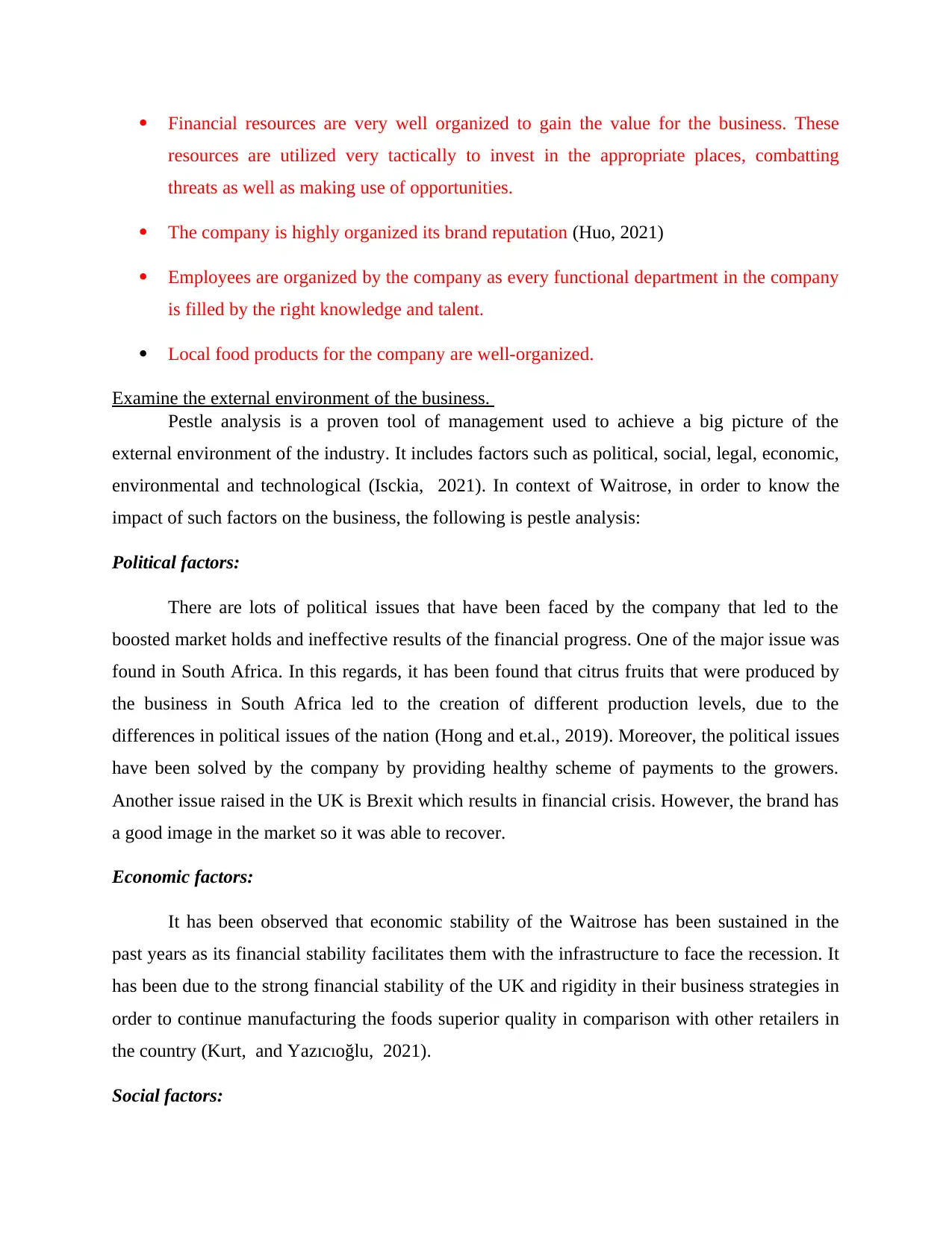
Financial resources are very well organized to gain the value for the business. These
resources are utilized very tactically to invest in the appropriate places, combatting
threats as well as making use of opportunities.
The company is highly organized its brand reputation (Huo, 2021)
Employees are organized by the company as every functional department in the company
is filled by the right knowledge and talent.
Local food products for the company are well-organized.
Examine the external environment of the business.
Pestle analysis is a proven tool of management used to achieve a big picture of the
external environment of the industry. It includes factors such as political, social, legal, economic,
environmental and technological (Isckia, 2021). In context of Waitrose, in order to know the
impact of such factors on the business, the following is pestle analysis:
Political factors:
There are lots of political issues that have been faced by the company that led to the
boosted market holds and ineffective results of the financial progress. One of the major issue was
found in South Africa. In this regards, it has been found that citrus fruits that were produced by
the business in South Africa led to the creation of different production levels, due to the
differences in political issues of the nation (Hong and et.al., 2019). Moreover, the political issues
have been solved by the company by providing healthy scheme of payments to the growers.
Another issue raised in the UK is Brexit which results in financial crisis. However, the brand has
a good image in the market so it was able to recover.
Economic factors:
It has been observed that economic stability of the Waitrose has been sustained in the
past years as its financial stability facilitates them with the infrastructure to face the recession. It
has been due to the strong financial stability of the UK and rigidity in their business strategies in
order to continue manufacturing the foods superior quality in comparison with other retailers in
the country (Kurt, and Yazıcıoğlu, 2021).
Social factors:
resources are utilized very tactically to invest in the appropriate places, combatting
threats as well as making use of opportunities.
The company is highly organized its brand reputation (Huo, 2021)
Employees are organized by the company as every functional department in the company
is filled by the right knowledge and talent.
Local food products for the company are well-organized.
Examine the external environment of the business.
Pestle analysis is a proven tool of management used to achieve a big picture of the
external environment of the industry. It includes factors such as political, social, legal, economic,
environmental and technological (Isckia, 2021). In context of Waitrose, in order to know the
impact of such factors on the business, the following is pestle analysis:
Political factors:
There are lots of political issues that have been faced by the company that led to the
boosted market holds and ineffective results of the financial progress. One of the major issue was
found in South Africa. In this regards, it has been found that citrus fruits that were produced by
the business in South Africa led to the creation of different production levels, due to the
differences in political issues of the nation (Hong and et.al., 2019). Moreover, the political issues
have been solved by the company by providing healthy scheme of payments to the growers.
Another issue raised in the UK is Brexit which results in financial crisis. However, the brand has
a good image in the market so it was able to recover.
Economic factors:
It has been observed that economic stability of the Waitrose has been sustained in the
past years as its financial stability facilitates them with the infrastructure to face the recession. It
has been due to the strong financial stability of the UK and rigidity in their business strategies in
order to continue manufacturing the foods superior quality in comparison with other retailers in
the country (Kurt, and Yazıcıoğlu, 2021).
Social factors:
⊘ This is a preview!⊘
Do you want full access?
Subscribe today to unlock all pages.

Trusted by 1+ million students worldwide
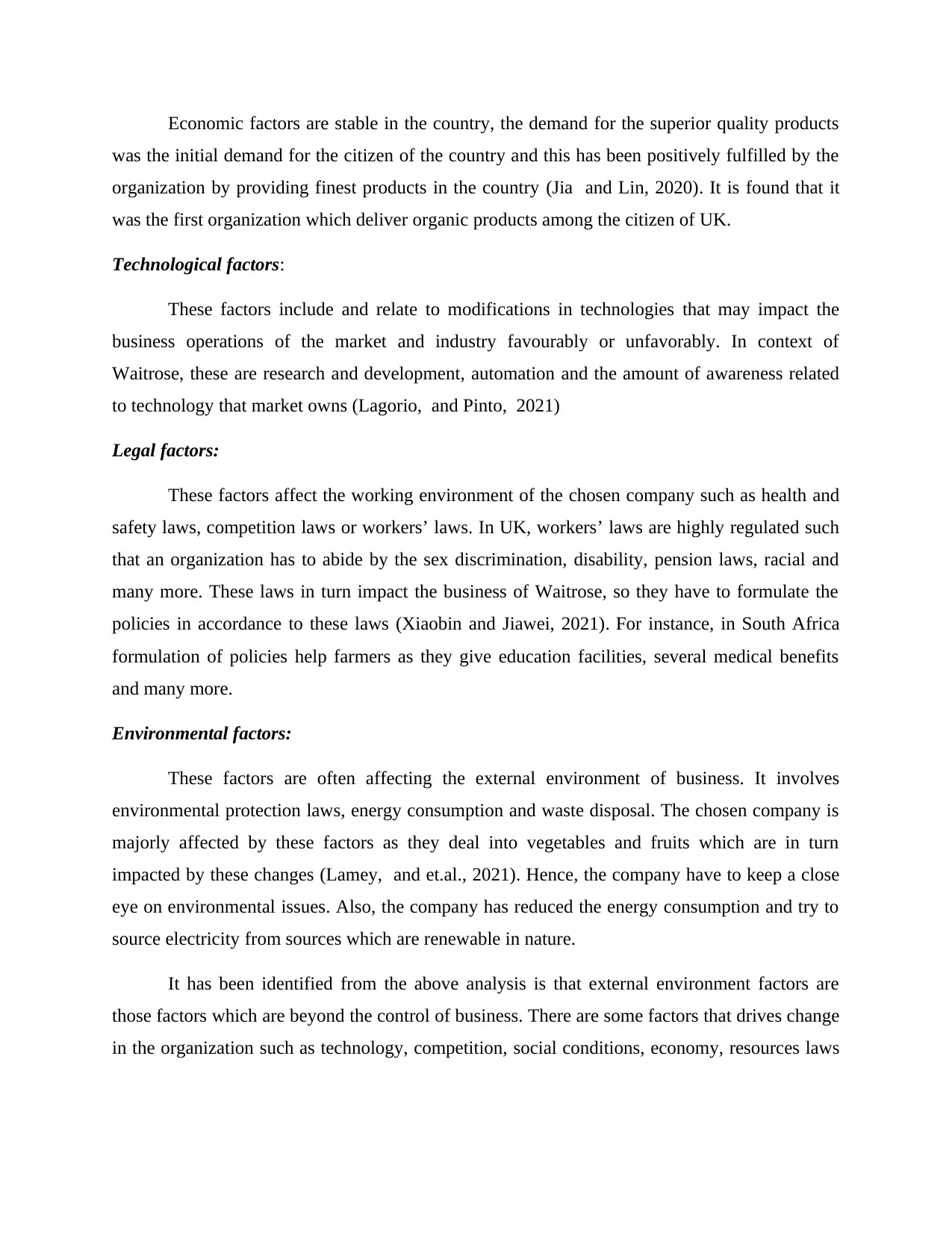
Economic factors are stable in the country, the demand for the superior quality products
was the initial demand for the citizen of the country and this has been positively fulfilled by the
organization by providing finest products in the country (Jia and Lin, 2020). It is found that it
was the first organization which deliver organic products among the citizen of UK.
Technological factors:
These factors include and relate to modifications in technologies that may impact the
business operations of the market and industry favourably or unfavorably. In context of
Waitrose, these are research and development, automation and the amount of awareness related
to technology that market owns (Lagorio, and Pinto, 2021)
Legal factors:
These factors affect the working environment of the chosen company such as health and
safety laws, competition laws or workers’ laws. In UK, workers’ laws are highly regulated such
that an organization has to abide by the sex discrimination, disability, pension laws, racial and
many more. These laws in turn impact the business of Waitrose, so they have to formulate the
policies in accordance to these laws (Xiaobin and Jiawei, 2021). For instance, in South Africa
formulation of policies help farmers as they give education facilities, several medical benefits
and many more.
Environmental factors:
These factors are often affecting the external environment of business. It involves
environmental protection laws, energy consumption and waste disposal. The chosen company is
majorly affected by these factors as they deal into vegetables and fruits which are in turn
impacted by these changes (Lamey, and et.al., 2021). Hence, the company have to keep a close
eye on environmental issues. Also, the company has reduced the energy consumption and try to
source electricity from sources which are renewable in nature.
It has been identified from the above analysis is that external environment factors are
those factors which are beyond the control of business. There are some factors that drives change
in the organization such as technology, competition, social conditions, economy, resources laws
was the initial demand for the citizen of the country and this has been positively fulfilled by the
organization by providing finest products in the country (Jia and Lin, 2020). It is found that it
was the first organization which deliver organic products among the citizen of UK.
Technological factors:
These factors include and relate to modifications in technologies that may impact the
business operations of the market and industry favourably or unfavorably. In context of
Waitrose, these are research and development, automation and the amount of awareness related
to technology that market owns (Lagorio, and Pinto, 2021)
Legal factors:
These factors affect the working environment of the chosen company such as health and
safety laws, competition laws or workers’ laws. In UK, workers’ laws are highly regulated such
that an organization has to abide by the sex discrimination, disability, pension laws, racial and
many more. These laws in turn impact the business of Waitrose, so they have to formulate the
policies in accordance to these laws (Xiaobin and Jiawei, 2021). For instance, in South Africa
formulation of policies help farmers as they give education facilities, several medical benefits
and many more.
Environmental factors:
These factors are often affecting the external environment of business. It involves
environmental protection laws, energy consumption and waste disposal. The chosen company is
majorly affected by these factors as they deal into vegetables and fruits which are in turn
impacted by these changes (Lamey, and et.al., 2021). Hence, the company have to keep a close
eye on environmental issues. Also, the company has reduced the energy consumption and try to
source electricity from sources which are renewable in nature.
It has been identified from the above analysis is that external environment factors are
those factors which are beyond the control of business. There are some factors that drives change
in the organization such as technology, competition, social conditions, economy, resources laws
Paraphrase This Document
Need a fresh take? Get an instant paraphrase of this document with our AI Paraphraser

and regulations, labour markets and many more. Hence, managers of the company required to
identify the methods to face and overcome the changes effectively.
Using Porter’s Five Force framework to evaluate the impact of competitive forces.
Michael porter's five force analysis focuses on the external factors in an industry that
influences the competition within it, but within the industry these competitions provide high
profitability for the business. An organization needs to acknowledge the dynamics of the markets
and industry with an aim to deliver tough competition in the marketplace. Porter explained the
five forces that drives competition, rivalry among the present organization, threats of
alternatives, bargaining power of suppliers, bargaining power of customers and the threat of new
entrants (Li, and et.al., 2021).In order to evaluate the impact of competitive forces and to gain
competitive benefits for the Waitrose, the following is using the Porter’s five forces model:
identify the methods to face and overcome the changes effectively.
Using Porter’s Five Force framework to evaluate the impact of competitive forces.
Michael porter's five force analysis focuses on the external factors in an industry that
influences the competition within it, but within the industry these competitions provide high
profitability for the business. An organization needs to acknowledge the dynamics of the markets
and industry with an aim to deliver tough competition in the marketplace. Porter explained the
five forces that drives competition, rivalry among the present organization, threats of
alternatives, bargaining power of suppliers, bargaining power of customers and the threat of new
entrants (Li, and et.al., 2021).In order to evaluate the impact of competitive forces and to gain
competitive benefits for the Waitrose, the following is using the Porter’s five forces model:
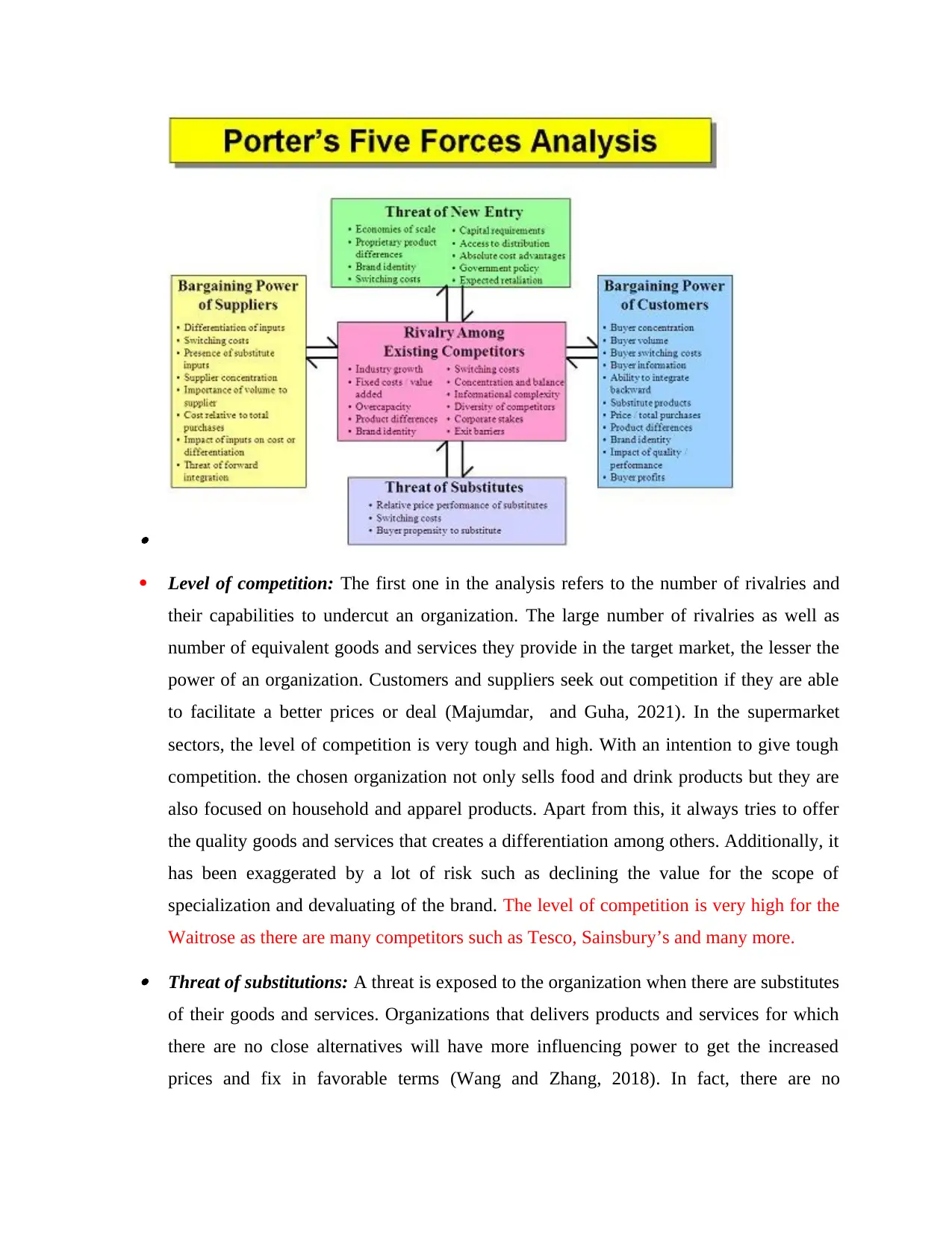
Level of competition: The first one in the analysis refers to the number of rivalries and
their capabilities to undercut an organization. The large number of rivalries as well as
number of equivalent goods and services they provide in the target market, the lesser the
power of an organization. Customers and suppliers seek out competition if they are able
to facilitate a better prices or deal (Majumdar, and Guha, 2021). In the supermarket
sectors, the level of competition is very tough and high. With an intention to give tough
competition. the chosen organization not only sells food and drink products but they are
also focused on household and apparel products. Apart from this, it always tries to offer
the quality goods and services that creates a differentiation among others. Additionally, it
has been exaggerated by a lot of risk such as declining the value for the scope of
specialization and devaluating of the brand. The level of competition is very high for the
Waitrose as there are many competitors such as Tesco, Sainsbury’s and many more. Threat of substitutions: A threat is exposed to the organization when there are substitutes
of their goods and services. Organizations that delivers products and services for which
there are no close alternatives will have more influencing power to get the increased
prices and fix in favorable terms (Wang and Zhang, 2018). In fact, there are no
Level of competition: The first one in the analysis refers to the number of rivalries and
their capabilities to undercut an organization. The large number of rivalries as well as
number of equivalent goods and services they provide in the target market, the lesser the
power of an organization. Customers and suppliers seek out competition if they are able
to facilitate a better prices or deal (Majumdar, and Guha, 2021). In the supermarket
sectors, the level of competition is very tough and high. With an intention to give tough
competition. the chosen organization not only sells food and drink products but they are
also focused on household and apparel products. Apart from this, it always tries to offer
the quality goods and services that creates a differentiation among others. Additionally, it
has been exaggerated by a lot of risk such as declining the value for the scope of
specialization and devaluating of the brand. The level of competition is very high for the
Waitrose as there are many competitors such as Tesco, Sainsbury’s and many more. Threat of substitutions: A threat is exposed to the organization when there are substitutes
of their goods and services. Organizations that delivers products and services for which
there are no close alternatives will have more influencing power to get the increased
prices and fix in favorable terms (Wang and Zhang, 2018). In fact, there are no
⊘ This is a preview!⊘
Do you want full access?
Subscribe today to unlock all pages.

Trusted by 1+ million students worldwide
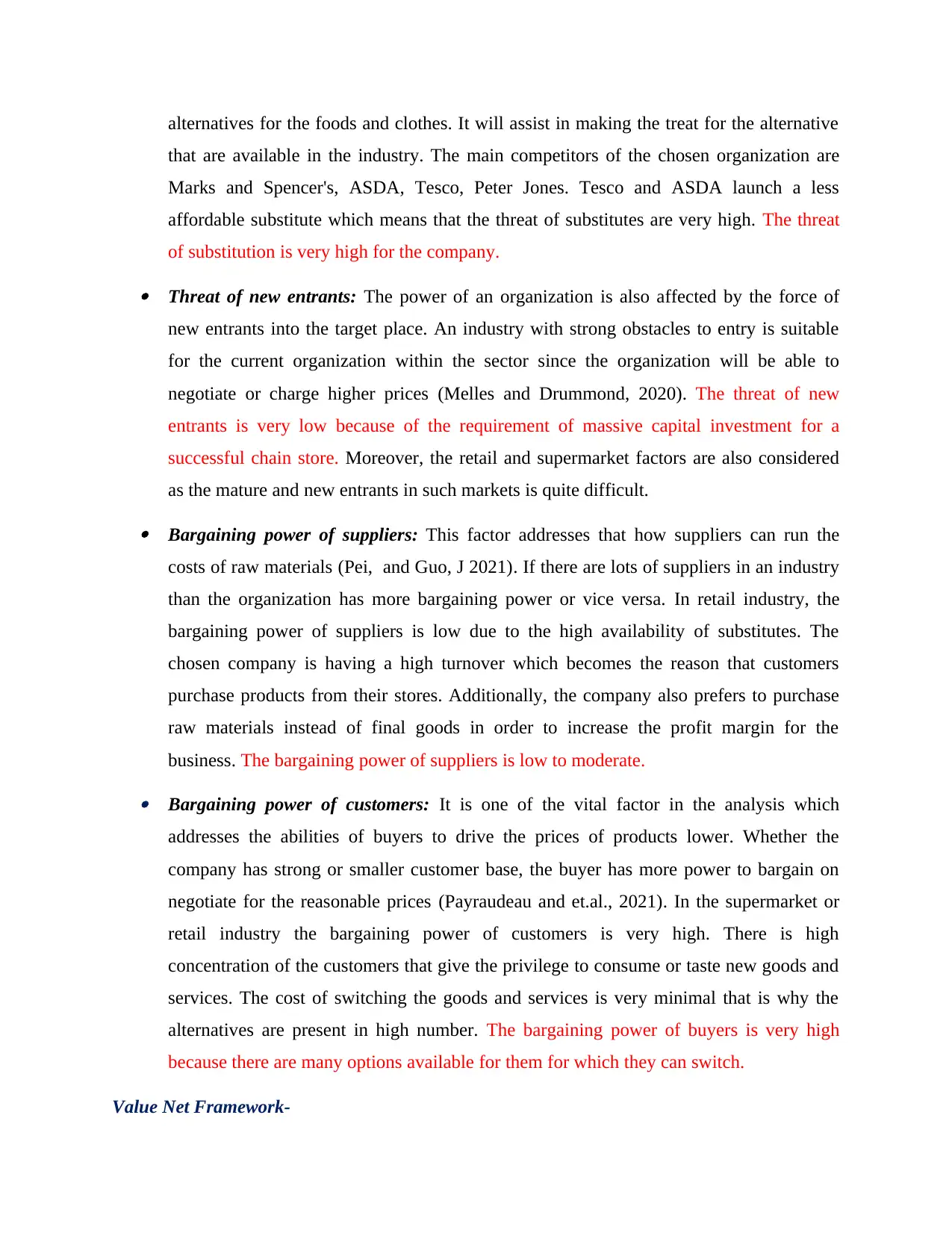
alternatives for the foods and clothes. It will assist in making the treat for the alternative
that are available in the industry. The main competitors of the chosen organization are
Marks and Spencer's, ASDA, Tesco, Peter Jones. Tesco and ASDA launch a less
affordable substitute which means that the threat of substitutes are very high. The threat
of substitution is very high for the company. Threat of new entrants: The power of an organization is also affected by the force of
new entrants into the target place. An industry with strong obstacles to entry is suitable
for the current organization within the sector since the organization will be able to
negotiate or charge higher prices (Melles and Drummond, 2020). The threat of new
entrants is very low because of the requirement of massive capital investment for a
successful chain store. Moreover, the retail and supermarket factors are also considered
as the mature and new entrants in such markets is quite difficult. Bargaining power of suppliers: This factor addresses that how suppliers can run the
costs of raw materials (Pei, and Guo, J 2021). If there are lots of suppliers in an industry
than the organization has more bargaining power or vice versa. In retail industry, the
bargaining power of suppliers is low due to the high availability of substitutes. The
chosen company is having a high turnover which becomes the reason that customers
purchase products from their stores. Additionally, the company also prefers to purchase
raw materials instead of final goods in order to increase the profit margin for the
business. The bargaining power of suppliers is low to moderate. Bargaining power of customers: It is one of the vital factor in the analysis which
addresses the abilities of buyers to drive the prices of products lower. Whether the
company has strong or smaller customer base, the buyer has more power to bargain on
negotiate for the reasonable prices (Payraudeau and et.al., 2021). In the supermarket or
retail industry the bargaining power of customers is very high. There is high
concentration of the customers that give the privilege to consume or taste new goods and
services. The cost of switching the goods and services is very minimal that is why the
alternatives are present in high number. The bargaining power of buyers is very high
because there are many options available for them for which they can switch.
Value Net Framework-
that are available in the industry. The main competitors of the chosen organization are
Marks and Spencer's, ASDA, Tesco, Peter Jones. Tesco and ASDA launch a less
affordable substitute which means that the threat of substitutes are very high. The threat
of substitution is very high for the company. Threat of new entrants: The power of an organization is also affected by the force of
new entrants into the target place. An industry with strong obstacles to entry is suitable
for the current organization within the sector since the organization will be able to
negotiate or charge higher prices (Melles and Drummond, 2020). The threat of new
entrants is very low because of the requirement of massive capital investment for a
successful chain store. Moreover, the retail and supermarket factors are also considered
as the mature and new entrants in such markets is quite difficult. Bargaining power of suppliers: This factor addresses that how suppliers can run the
costs of raw materials (Pei, and Guo, J 2021). If there are lots of suppliers in an industry
than the organization has more bargaining power or vice versa. In retail industry, the
bargaining power of suppliers is low due to the high availability of substitutes. The
chosen company is having a high turnover which becomes the reason that customers
purchase products from their stores. Additionally, the company also prefers to purchase
raw materials instead of final goods in order to increase the profit margin for the
business. The bargaining power of suppliers is low to moderate. Bargaining power of customers: It is one of the vital factor in the analysis which
addresses the abilities of buyers to drive the prices of products lower. Whether the
company has strong or smaller customer base, the buyer has more power to bargain on
negotiate for the reasonable prices (Payraudeau and et.al., 2021). In the supermarket or
retail industry the bargaining power of customers is very high. There is high
concentration of the customers that give the privilege to consume or taste new goods and
services. The cost of switching the goods and services is very minimal that is why the
alternatives are present in high number. The bargaining power of buyers is very high
because there are many options available for them for which they can switch.
Value Net Framework-
Paraphrase This Document
Need a fresh take? Get an instant paraphrase of this document with our AI Paraphraser

The value net model explains that competition and cooperation between companies are both
desirable and necessary when conducting business. This framework explains and examine the
behavior of various players within the industry. In this framework cooperation is needed to boost
the advantages to all competitors where as competition is required to categorize the current
advantages among such competitors. In case of Waitrose, to produce a framework it is supportive
to consider the five elements of players, added value, rules, tactics as well as scope: Players: It is the first step in which organization should determine its competitors or
players in the relevant industry or game that it operates in. These players include
suppliers, customers, competitors and complementors. External players who are not the
part of the game should also be focused (Pflaum and Gölzer, 2018). In case of the chosen
organization, it must examine each and every player to determine the potentiality for the
future strategic alliance. Added value: It explains what each player in their particular role can deliver a potential
alliance. The company conducting this model should also be determined the value it
delivers through competitive advantage or USP. Rules: Each game and industry has its own regulations as well as rules and these can
hinder the growth and development of a business. In case of Waitrose, it can find the
players who can remove some of these barriers through collaboration and partnerships
Tactics: Competitive organization is dynamic, complicated as well as uncertain game.
Most of the organizations also use strategies or tactics to influence the behavior of other
players in the game (Xu, Bo, and Chen, 2021).
Scope: By its nature, games are not static entities. Businessman should always be
prepared for the scope that can shrink or expands according to the market conditions or
its fluctuations.
CONCLUSION
It has been concluded from the report is that business strategy involves a set of actions
which helps company to gain long-term objectives for the business. The report is mentioned with
different tools to analyze the internal and external environment of working. In order to analyze
desirable and necessary when conducting business. This framework explains and examine the
behavior of various players within the industry. In this framework cooperation is needed to boost
the advantages to all competitors where as competition is required to categorize the current
advantages among such competitors. In case of Waitrose, to produce a framework it is supportive
to consider the five elements of players, added value, rules, tactics as well as scope: Players: It is the first step in which organization should determine its competitors or
players in the relevant industry or game that it operates in. These players include
suppliers, customers, competitors and complementors. External players who are not the
part of the game should also be focused (Pflaum and Gölzer, 2018). In case of the chosen
organization, it must examine each and every player to determine the potentiality for the
future strategic alliance. Added value: It explains what each player in their particular role can deliver a potential
alliance. The company conducting this model should also be determined the value it
delivers through competitive advantage or USP. Rules: Each game and industry has its own regulations as well as rules and these can
hinder the growth and development of a business. In case of Waitrose, it can find the
players who can remove some of these barriers through collaboration and partnerships
Tactics: Competitive organization is dynamic, complicated as well as uncertain game.
Most of the organizations also use strategies or tactics to influence the behavior of other
players in the game (Xu, Bo, and Chen, 2021).
Scope: By its nature, games are not static entities. Businessman should always be
prepared for the scope that can shrink or expands according to the market conditions or
its fluctuations.
CONCLUSION
It has been concluded from the report is that business strategy involves a set of actions
which helps company to gain long-term objectives for the business. The report is mentioned with
different tools to analyze the internal and external environment of working. In order to analyze
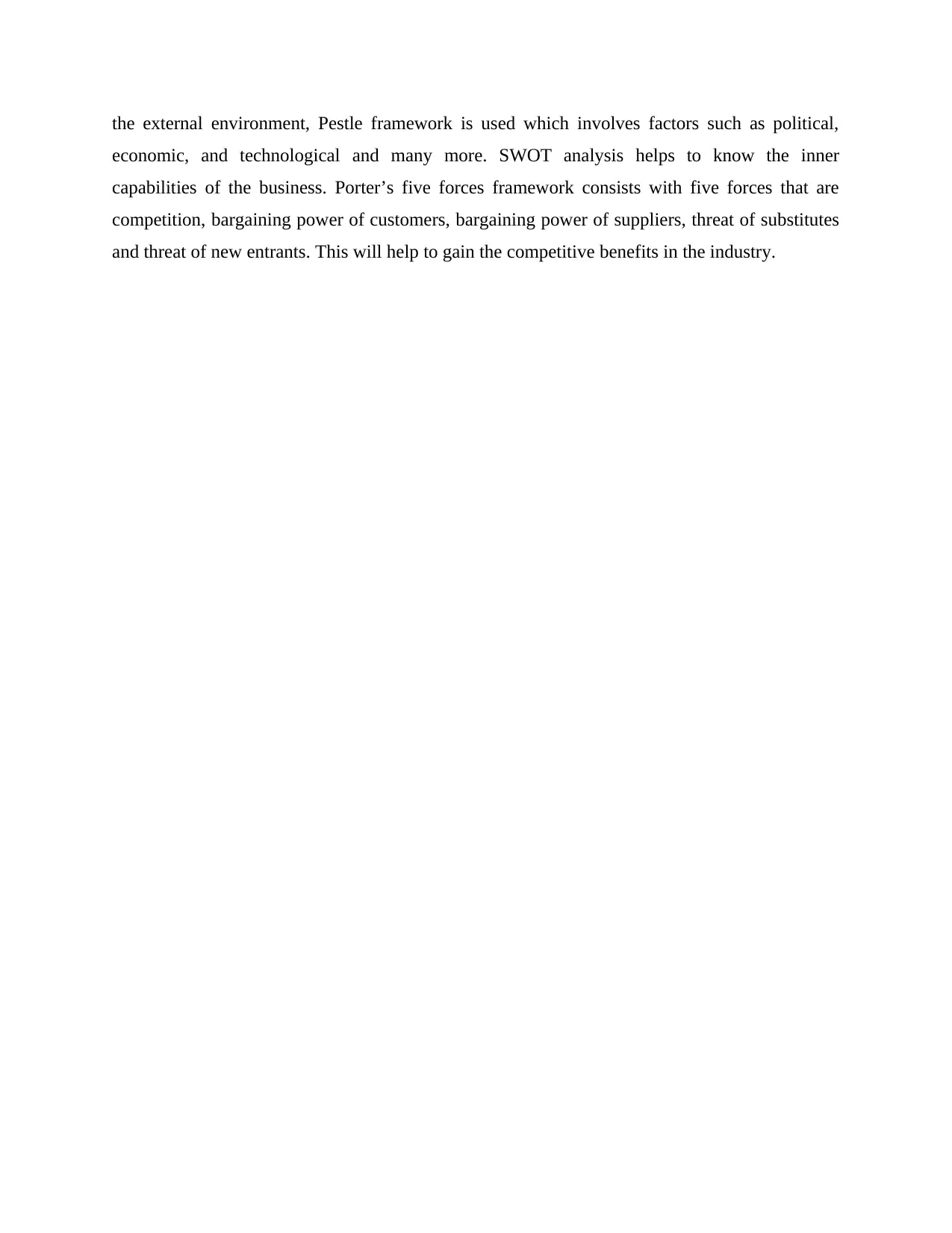
the external environment, Pestle framework is used which involves factors such as political,
economic, and technological and many more. SWOT analysis helps to know the inner
capabilities of the business. Porter’s five forces framework consists with five forces that are
competition, bargaining power of customers, bargaining power of suppliers, threat of substitutes
and threat of new entrants. This will help to gain the competitive benefits in the industry.
economic, and technological and many more. SWOT analysis helps to know the inner
capabilities of the business. Porter’s five forces framework consists with five forces that are
competition, bargaining power of customers, bargaining power of suppliers, threat of substitutes
and threat of new entrants. This will help to gain the competitive benefits in the industry.
⊘ This is a preview!⊘
Do you want full access?
Subscribe today to unlock all pages.

Trusted by 1+ million students worldwide
1 out of 14
Related Documents
Your All-in-One AI-Powered Toolkit for Academic Success.
+13062052269
info@desklib.com
Available 24*7 on WhatsApp / Email
![[object Object]](/_next/static/media/star-bottom.7253800d.svg)
Unlock your academic potential
Copyright © 2020–2025 A2Z Services. All Rights Reserved. Developed and managed by ZUCOL.





